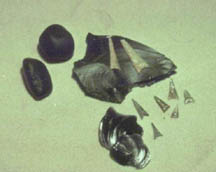|
METHOD AND
THEORY IN LITHIC TECHNOLOGY
GRADUATE
SEMINAR, ANTH 228
FALL 2001
Department of Anthropology
University of California,
Berkeley
Tuesday 10-12, Rm. 16, Hearst Gym
M. Steven
Shackley
Office: Kroeber #29, 643-1193, x-3; [email protected]
Office Hours: Th:1-3, and by appt.

Side-notched
projectile points produced by Ishi at the Museum

Obsidian
marekanites, flakes and projectile points from Late Classic Tonto Basin,
Arizona sites |
Seminar level overview of current method and theory in lithic technology. The
geographic focus will be worldwide, although the emphasis will be topical. Major
topics of discussion will include archaeometric methods in the service of lithic
technology (NAA, XRF in raw material studies; ESEM in utilization studies;
optical petrography), procurement and production, debitage analysis, style,
ethnicity and gender studies, experimental technology (replication studies),
use-wear studies, ethnoarchaeology, analytical and laboratory methods; critical
examination of various theoretical approaches to stone tool analysis. Additional
class time outside of class (depending on weather) will be devoted to
flintknapping practice including replication, and an examination of the obsidian
debitage and Archaic projectile points from McEuen Cave (AZ W:13:6 ASM), a hunter-gatherer
to farmer transition rockshelter site in southeastern Arizona.
Weekly reading on topics will provide the basis for seminar discussion. All
students are expected to read assigned material and participate in discussions.
Recommended texts: Andrefsky, W. (1998) "Lithics: Macroscopic Approaches to
Analysis" and Whittaker, J. (1994) "Flintknapping".
Requirements:
Graduate students only. Classroom participation and a research paper. No
exams. Research paper should focus on one or more of the topics discussed in
class, an ongoing project, or the analysis of a portion of the McEuen Cave assemblage.
One or more students will be required to guide the discussion each week
drawing on assigned readings, with the possible addition of one or two more
readings of your choice. These students are responsible for providing copies of
all readings, and making them available at a pre-arranged location. Many of the
readings will be in reserved books in the Anthro library.
Flintknapping toolkit
Those without knapping gear may purchase a tool kit plus moose antler billet
from Great Lakes Lithics (www.greatlakeslithics.com), 888-316-4667, 3168
W. Shore Dr., Battle Creek, MI 49017. Frank Stevens will give us a good price.
Order the beginner kit, plus a small finished antler billet, and tell him you’re
taking this class. This tool kit will last many years. Price approximately
$50.00. I also recommend that you carry a 10x hand lens.
CALENDAR (subject to revision) ANTH 228
DATE
SUBJECT (reading list for the week is hot linked to PDF files)
------------------------------------------------------
August 28 Introduction -
General discussion, course structure
September 4 Archaeometry and Lithic Technology -
Shackley
September 11 Procurement,
production and processing
September 18 Ethnology and ethnoarchaeology
September 25 Debitage and bipolar production
October
2 Analytical/laboratory
strategies
October 9
Lab Day - Lab examination of McEuen Cave debitage
October 16
Experimental technology (replication studies)
October 23
Use
wear/heat treatment
October 30
Style, ethnicity and cultural identity
November 6 Lab Day
- Projectile point analysis in lab
November 13 Typology versus attribute
analysis (Old versus New World approaches)
November 20 Gender, cognitive and
post-processual approaches and the 21st Century
November 27/
December 4 RESEARCH
TIME FOR PAPERS OR PROJECTS
December 11
RESEARCH/PROJECT
PAPERS DUE!: 103 Kroeber Hall, 4 pm, or 232 Kroeber Hall by 5 pm.


Recommended reading
(available at the PAHMA store and
campus textbooks)

A metric scheme for Southwest Archaic projectile
points (from Shackley 1990).
Images





